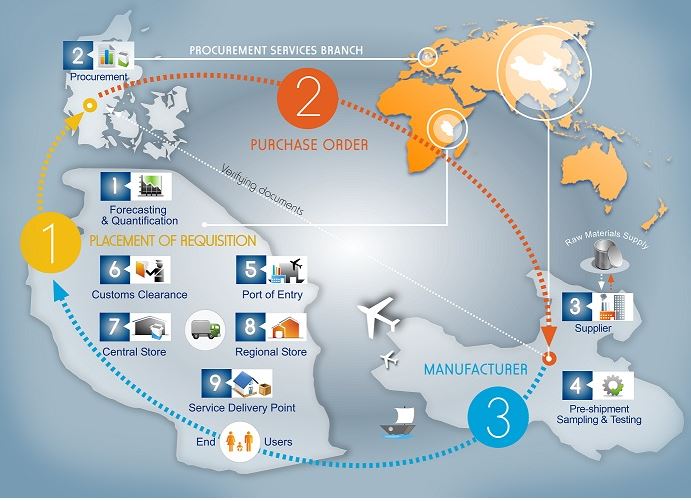
Supply chain management is not the same as logistics, which concern the movement of goods from one place to another. Supply chain management is complex management of the flow of information, finance and goods from end-to-end to ensure the right product, at the right place and at the right time
One of UNFPA’s commitments at the London Summit for Family Planning in London in July 2012 was to reduce stock-outs of family planning supplies through effective supply chain management. For many of our programmes, commodities are necessary for the successful delivery of programme goals. Thus focusing attention on the obstacles faced in the supply chain of our products are essential for ensuring that women have access to family planning and can make choices about the methods they use.
The supply chain for RH commodities includes all personnel, systems and equipment that are needed to effectively deliver RH products from the point of production all way to the users that need the products. Regardless of the products in the supply chain, effective supply chain management includes not simply in-country logistics, meaning shipping, storing and the delivery of commodities but also includes the effective integration of programme and financial planning, forecasting with valid and reliable data, production and procurement to create a seamless, end-to-end process. Modern supply chains rely on synchronization between the different links. Optimization in just one link, such as air transport, for example, can lead to more acute bottlenecks further down the chain as those links may not be able to cope with the quicker influx of commodities. Supply chain management in the private sector has moved away from relying on buffer stocks. Instead excessive inventories are seen as an indicator of uncertainty and weakness in the supply chain. Whereas some buffer stock is needed to guard against uncertainties, reliable forecasting, proper planning and appropriate production all lessen the need for large quantities in buffer stock. Most countries that UNFPA procures for have a complex SC process with several activities from the forecasting and quantification, manufacturing, storage in port of entry awaiting customs clearance and possible post-shipment testing to the central storage and all the way to the service delivery points. In addition, the system is often decentralized with several stakeholders controlling different parts of the supply chain. At all these points records must be maintained by paper. Complex distribution systems increase the likelihood of bottlenecks. These bottle-necks can result in stock-outs of essential maternal medicines and family planning products.
The Global Programme for Reproductive Health Commodity Security is UNFPA’s main channel for providing technical and financial assistance for family planning. UNFPA also facilitates third-party procurement of essential reproductive health commodities.
In low and middle income countries, there is often a gap between that segment of the supply chain that entails the production and transport of the commodities to the port of entry and the segment which further distributes the commodities from the port of entry to the end-user. The data quality on distribution and consumption of the commodities is often untimely, unreliable and incomplete leading in turn to poorer forecasting and quantification which in turn affects commodity production and attendant higher costs at the beginning of the chain.This leads to sub-optimal decisions being made and ultimately and increased risk of stock-outs. In the view of UNFPA, there is a need to focus more closely on forecasting and optimizing in country distribution processes of RH commodities to ensure that commodities reach those who need them, when they need them.
This entails a stronger focus on the last mile of distribution, and attention to gathering and ensuring quality data on distribution and consumption, which in turn can inform the start of the supply chain through better forecasting and appropriate production to meet needs.
This portal will provide information, tools and guidance on the different parts of the UNFPA supply chain which will be of interest to UNFPA operations staff, programme officers and partners alike